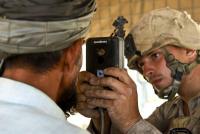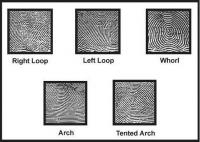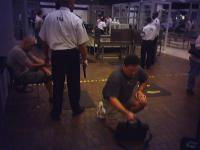-
Faster airport lines with facial recognition
More and more people are travelling by plane, so automating airport security checks makes sense. The use of biometric features is a way to identify people at airports. New technology detects and tracks you from the second you arrive at the airport until you’re out of the arrivals hall at your destination.
-
-
Senior Russian security officials exhibit “gunslinger gait”: Experts

Experts have discovered a new gait pattern among several top Russian officials, including President Vladimir Putin and Prime Minister Dmitry Medvedev. The researchers term this “gunslinger’s gait” because it may be triggered by KGB or other forms of weaponry training. The gait features a consistently reduced right-sided arm swing, highlighted in video material of the individuals studied.
-
-
New biometric measures to identify, track refugees

Refugees applying to come to the United States go through several different security measures aiming to make sure that they who they say they are, and that they are involved with terror organizations or criminal gangs. The security screening includes detailed interviews, three levels of background checks, three fingerprint screenings, contagious disease screening, and cultural orientation. The United States has plans in the works for additional biometric measures, including iris scanning and rapid-turnaround DNA testing.
-
-
CBP begins biometric entry/exit testing at Otay Mesa port of entry

U.S. Customs and Border Protection (CBP) will begin testing new biometric technology at the Otay Mesa pedestrian crossing this week to enhance identification of certain non-U.S. citizens entering and exiting the United States. CBP says its Entry/Exit strategy includes three core pillars: identify and close the biographic gaps and enhance the entry-exit system; perform targeted biometric operations; and transform the entry/exit process through the use of emerging biometric technologies.
-
-
Large-scale face-search technology helps in fighting crime, terrorism

The rapid growth in surveillance cameras is resulting in millions of face images and videos captured every day. The ability quickly and accurately to search all these images to assist in identifying criminal and terrorism suspects is an important and complex task that can contribute to making communities safer. To help in this effort, MSU has licensed its large-scale, automatic face-search system to NEC Corp.
-
-
New technique can tell whether a fingerprint belongs to a male or female

Culprits beware: researchers are taking crime scene fingerprint identification to a new level. They have discovered a straightforward concept for identifying whether a culprit is male or female. It is based on the content in fingerprints — specifically amino acids. Amino acid levels in the sweat of females are about twice as high as in males. There is also a slightly different distribution, due mostly to hormonal differences. The same is true for amino acids left behind in fingerprints.
-
-
DNA identification may not be as reliable as previously thought

Increasingly important to criminal investigations, DNA analysis once required substantial samples of blood or other bodily fluids, but advances in the field now make it possible to produce a complete genetic profile of a suspect from just a few cells left behind — so-called “touch DNA.” A new study shows that secondary transfer of human DNA through intermediary contact is far more common than previously thought, a finding that could have serious repercussions for medical science and the criminal justice system.
-
-
Glowing fingerprints help fight crime
Fingerprint identification has been used as a key method by law enforcement and forensic experts for over 100 years. Researchers say that by adding a drop of liquid containing crystals to surfaces, investigators using a UV light are able to see invisible fingerprints “glow” in about thirty seconds. The strong luminescent effect creates greater contrast between the latent print and surface enabling higher resolution images to be taken for easier and more precise analyses.
-
-
Internal fingerprint sensor enables more accurate ID
In the 1971 film “Diamonds are Forever,” British secret agent James Bond uses fake fingerprints as part of a ploy to assume the identity of a diamond smuggler. At the time, sham prints were purely a futuristic bit of Bond gadgetry, but technology has since caught up. Quickly detecting “internal fingerprints” and sweat pores could make fingerprint sensors more reliable and less likely to be tricked by fake fingerprints.
-
-
Expert passport officers better than face recognition technology in detecting fraud
Face-matching experts at the Australian Passport Office are 20 percent more accurate than average people at detecting fraud using automatic face recognition software, new research shows. The study is the first to test how well people perform on this difficult but common operational task carried out by passport officers. “Our research shows that accuracy can be significantly improved by recruiting staff who are naturally good at face recognition - the so-called “super-recognizers” — and then giving them in-depth training in the use of the software,” said the study lead author.
-
-
Forensic facial examiners can be near perfect

In what might be the first face-off of its kind, trained forensics examiners from the FBI and law enforcement agencies worldwide were far more accurate in identifying faces in photographs than nonexperts and even computers. The new assessment provides “the first strong evidence that facial forensic examiners are better at face recognition than the rest of us,” says a face recognition researcher.
-
-
Automated voice imitation can defeat voice-recognition security
Voice biometrics is based on the assumption that each person has a unique voice that depends not only on his or her physiological features of vocal cords but also on his or her entire body shape, and on the way sound is formed and articulated. Researchers have found that automated and human verification for voice-based user authentication systems are vulnerable to voice impersonation attacks. Using an off-the-shelf voice-morphing tool, the researchers developed a voice impersonation attack to attempt to penetrate automated and human verification systems.
-
-
Bringing contactless fingerprint technology to market

Quickly moving through security checkpoints by showing your hand to a scanner seems straight out of science fiction, but work is being done to bring fast, touchless fingerprint readers out of the lab and into the marketplace. The touchless technology offers speed and a hygienic alternative to conventional fingerprint readers.
-
-
Determining the age of fingerprints
Watch the imprint of a tire track in soft mud, and it will slowly blur, the ridges of the pattern gradually flowing into the valleys. Researchers have tested the theory that a similar effect could be used to give forensic scientists something they’ve long wished for: A way to date fingerprints. Even the approximate age of a fingerprint can have a critical bearing on forensic results, as it can rule out some prints as being too old to be relevant to a crime scene. Military forensics experts would like to be able to date the multitude of fingerprints found on improvised bombs used by insurgents to winnow out prints of individuals who may simply have handled the components in a shop from those of the actual bombmakers.
-
-
U.S., Canada, Mexico create North American Trusted Traveler network

DHS said it has joined Public Safety Canada and the Secretariat of Governance of Mexico in outlining the first steps toward the creation of a North American Trusted Traveler network. The new agreement, signed on 10 July 2015, will make it easier for eligible travelers in the United States, Mexico, and Canada to apply for expedited screening programs. Eligible travelers will be able to apply for each program beginning in 2016.
-
- All
- Regional
- Water
- Biometrics
- Borders/Immig
- Business
- Cybersecurity
- Detection
- Disasters
- Government
- Infrastructure
- International
- Public health
- Public Safety
- Communication interoperabillity
- Emergency services
- Emergency medical services
- Fire
- First response
- IEDs
- Law Enforcement
- Law Enforcement Technology
- Military technology
- Nonlethal weapons
- Nuclear weapons
- Personal protection equipment
- Police
- Notification /alert systems
- Situational awareness
- Weapons systems
- Sci-Tech
- Sector Reports
- Surveillance
- Transportation
Advertising & Marketing: advertise@newswirepubs.com
Editorial: editor@newswirepubs.com
General: info@newswirepubs.com
2010-2011 © News Wire Publications, LLC News Wire Publications, LLC
220 Old Country Road | Suite 200 | Mineola | New York | 11501
Permissions and Policies
Editorial: editor@newswirepubs.com
General: info@newswirepubs.com
2010-2011 © News Wire Publications, LLC News Wire Publications, LLC
220 Old Country Road | Suite 200 | Mineola | New York | 11501
Permissions and Policies
